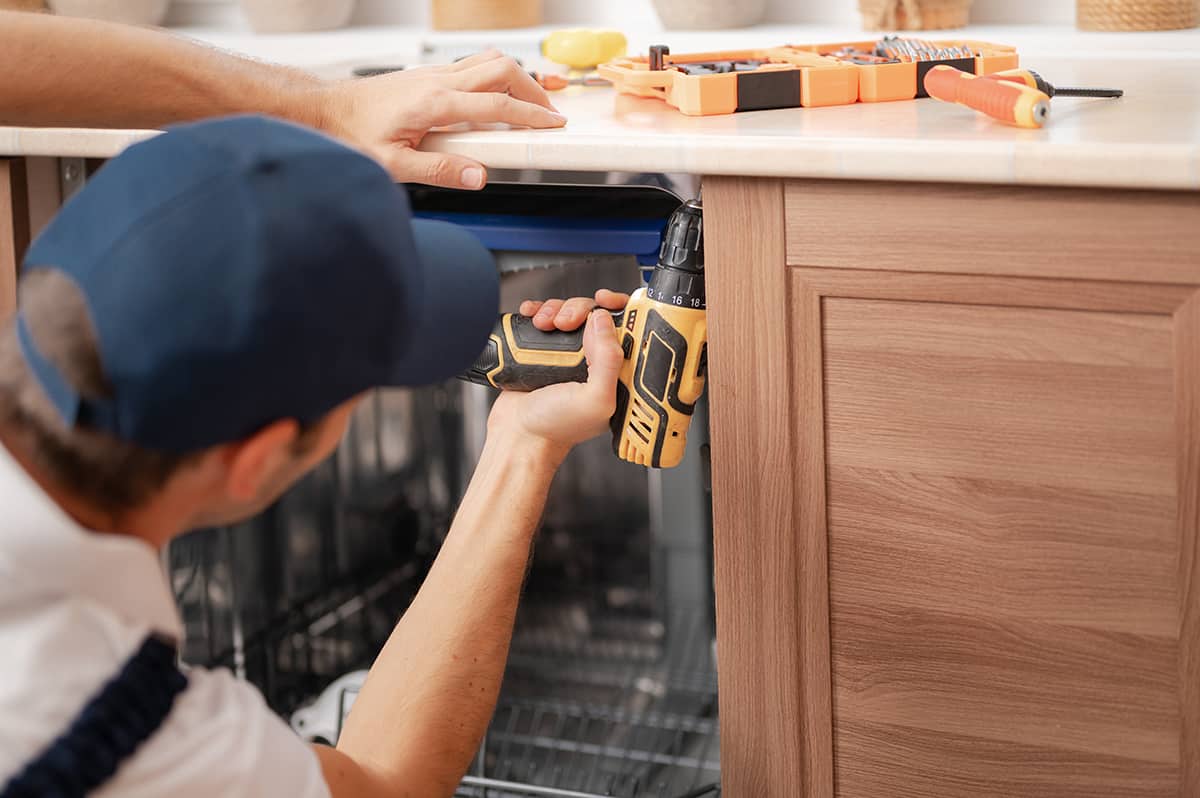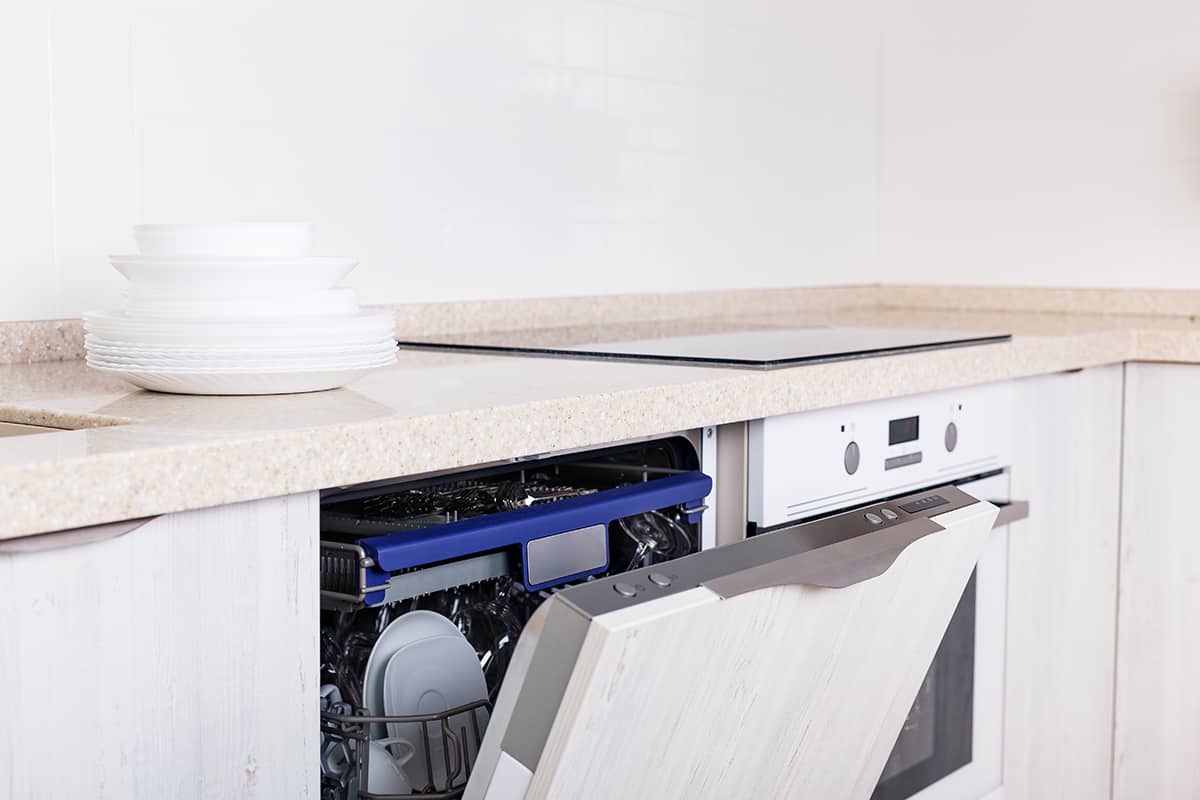Granite countertops are not what most people would call “affordable,” but they do look lovely, which is probably why we’re seeing them becoming more commonplace.
It’s a highly durable material that you can anchor your dishwasher under, and it provides a sturdy surface to prevent the appliances from rocking around. But if your dishwasher needs to be serviced, how do you remove it from underneath a granite countertop?
After shutting off your dishwasher, unloading the dishracks, and disconnecting the power cord and plumbing, you can remove your dishwasher from beneath a granite countertop by:
- Unscrew the mounting brackets
- Removing the adhesive
- Pulling the dishwasher out from beneath the granite countertop
If you’re still scratching your head about the process of detaching a dishwasher from under a granite countertop, don’t worry—in this guide, I’ll explain how to do this in more detail, as well as how to remove an epoxied dishwasher from under countertops.
Removing Dishwasher from Under Granite Countertop (Step by Step Guide)

Most people who choose granite countertops over other materials (quartz, ceramic, wood) mainly do so because of the aesthetics. However, there’s another benefit that granite offers, which is durability. With proper care—which isn’t that much, to be honest—a granite countertop can last for over three decades.
Also, granite offers stability when mounting certain appliances. Take, for instance, a dishwasher that is bolted to the underside of a granite countertop. Because of its weight, granite can prevent the dishwasher from rocking back and forth, so your dishes, cutlery, and glassware will remain safe and sound throughout the wash cycle.
However, there may come a time when you need to remove your dishwasher from underneath your granite countertops. Perhaps you want to have the machine serviced for one problem or another, or maybe you’re planning on moving homes. Whatever the case may be, here’s how you can safely remove your dishwasher from under granite countertops.
What You’ll Need
Before we get started, make sure you get your hands on the following equipment and supplies:
- A pair of dishwashing gloves
- A bucket (at least 2 gallons)
- A microfiber cloth or a roll of paper towels
- A putty knife
- A tester screwdriver
- An adhesive remover
- A floor rag
Preparing the Dishwasher for Removal
Before doing anything, you need to disconnect your dishwasher from its power source and water supply line. This includes unplugging the power cord, disconnecting it from your home’s circuit, and unloading the dishwasher.
- If you have a plug-in dishwasher, here’s what you need to do:
- Disconnect the power cord.
- Disconnect all of the plumbing to your dishwasher.
- Pour the water from the supply line and inlet valve into the bucket.
- Unload the dishwasher and take out the dishracks.
- Wipe away excess moisture from inside the dishwasher tub with the microfiber cloth or paper towels.
For dishwashers that are hardwired to your home’s electrical system, you’ll have to do the following:
- Disconnect all of the plumbing to your dishwasher.
- Shut off the flow of electricity by flipping the circuit breaker.
- Unscrew the front access panel or the kickplate.
- Look for the metal junction box and unscrew the cover.
- Use the tester screwdriver to check the dishwasher for electricity. If the tester screwdriver doesn’t detect electricity, proceed to the next step.
- Look for the wire nut that keeps the wires together and remove it.
- Unscrew the ground wire from the tab.
- Wipe away excess moisture from inside the dishwasher tub with the microfiber cloth or paper towels.
Now that your dishwasher is unplugged and unloaded let’s talk about how you can remove it from underneath a granite counter.
1. Unscrew the mounting brackets
Although dishwashers are typically attached to the underside of granite countertops with glue, you might have secured the dishwasher by attaching a mounting bracket. You would have used screws to anchor the dishwasher to the bracket, in which case, you will have to remove the screws before pulling the dishwasher out from underneath the counter.
2. Removing the adhesive
Mounting brackets are used as an extra form of security to keep a dishwasher in place underneath kitchen counters. However, when it comes to granite countertops, the primary method is to glue the dishwasher in place, which doesn’t cause damage to the dishwasher or the underside of your counters.
Luckily, getting rid of dishwasher glue is quite simple. All you need is an adhesive remover. Aim the nozzle between the top of your dishwasher and the underside of your counter. Spray the adhesive remover and let it sit for 5 minutes to take effect.
After the adhesive has dissolved, use the putty knife further loosen the glue until it detaches completely from the dishwasher. Repeat this if you also glued the sides of your dishwasher to the adjacent cabinet walls.
3. Pulling the dishwasher out from beneath the granite countertop
Now that your dishwasher is safely detached from your granite countertop, it’s time to wiggle it out of place. First, you will need to adjust the height of the dishwasher’s front legs. Lower them so that the front of the dishwasher dips slightly.
Place the floor rag directly in front of the bottom of the dishwasher. Carefully lift the front of the dishwasher until it is sitting on top of the rag. The rag will help you slide the dishwasher out more easily without having to lift the machine too high and risk scratching the top.
Ideally, you’ll have a second set of hands to help you slide the dishwasher out from its cabinet.
Do I Need a Professional Contractor to Remove My Dishwasher?
No, you don’t. Even if you had your dishwasher hooked up by a professional, you can, for the most part, remove it without paying for assistance.
That said, if you don’t feel confident about disconnecting the dishwasher from your home’s electrical system or disconnecting the various pipes and hoses that connect to the appliance, then it might be worth hiring a professional to do the job for you.
This is especially true in cases where your dishwasher has been epoxied in place.
How to Remove an Epoxied Dishwasher
Some contractors prefer epoxying appliances into place. As the epoxy cures, it creates a nearly indestructible adhesion between the dishwasher and the surface it’s adhered to—in this case, granite.
First, look for where the epoxy has been placed. Most of the time, the epoxy will connect the dishwasher’s mounting tabs to the mounting bracket or directly to the granite.
Now, you might not like this solution, but one of the most effective ways to remove an epoxied dishwasher is to cut off the tabs. You will need a pair of aviation snips to do the job reliably. Snip off all the tabs until the dishwasher is completely removed from the granite.
An alternative method, which I highly suggest doing if you don’t want to damage your dishwasher, is to use a multitool to carefully scrape away the epoxy adhesion.
Also, you could try heating up your putty knife to liquify the epoxy, but this method isn’t completely reliable. Plus, you risk damaging the underside of your granite counters.
If you only want to get your dishwasher serviced, see whether or not the repairman can come to your home to fix the machine. Nearly all dishwasher maintenance can be done from the front of the machine, so you don’t have to disconnect it at all. However, if you’re moving homes and want to take the dishwasher with you, you will need to try one of the aforementioned methods to remove the dishwasher completely.
Should I Install a Dishwasher Underneath the Counter?

After disconnecting your dishwasher and relocating to a new place, you’re probably wondering whether you should install the dishwasher underneath your new counter. Well, only you can decide whether or not it’s worth doing, but I will give you arguments from both sides.
For: Saves space
If you don’t have a ton of floor space in your kitchen, then you should think about installing an under-counter dishwasher. It will use up virtually unused space, and there’s very little risk that you or anyone else will bump into the machine.
For: Low noise output
Dishwashers make noise, and for some people, they make too much noise. If you don’t like listening to the constant droning of your dishwasher, you can place it in a cabinet and shut the door (optional). For freestanding dishwashers, you’ll have to live with the humming and buzzing of their motors.
Against: Difficulty
Unless you’re particularly handy around power tools and different adhesives, you might want to hire someone to install your dishwasher underneath your new counter. However, as you can see from this guide, removing the dishwasher for any reason can be a pain. On the other hand, a freestanding dishwasher can be installed and removed at any time with fewer steps.
Against: Moisture
As you are probably already aware, excess moisture in the kitchen can spell disaster. The problem with placing a dishwasher in such a cramped area is that it needs to be properly vented, which can be tricky if you don’t have a professional who can install the machine for you. Freestanding dishwashers don’t have this problem since their vents are uncovered.






